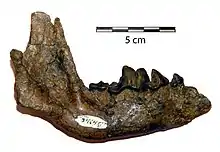Borophagus littoralis
Borophagus littoralis ("coastal glutton") is an extinct species of the genus Borophagus of the subfamily Borophaginae, a group of canids endemic to North America from the early Miocene epoch (23.3 Mya) through the Pliocene epoch (4.9 Mya). Borophagus littoralis existed for approximately 18.4 million years .[2]
| Borophagus littoralis[1] | |
|---|---|
 | |
| Scientific classification | |
| Kingdom: | Animalia |
| Phylum: | Chordata |
| Class: | Mammalia |
| Order: | Carnivora |
| Family: | Canidae |
| Genus: | †Borophagus |
| Species: | †B. littoralis |
| Binomial name | |
| †Borophagus littoralis VanderHoof, 1931 | |
Overview
Borophagus littoralis was named by Cope in 1892 and is considered synonymous with Osteoborus diabloensis. Borophagus littoralis, like other Borophaginae, are loosely known as "bone-crushing" or "hyena-like" dogs. Though not the most massive borophagine by size or weight, it had a more highly evolved capacity to crunch bone than earlier, larger genera such as Epicyon, which seems to be an evolutionary trend of the group (Turner, 2004). During the Pliocene epoch, Borophagus began being displaced by Canis genera such as Canis edwardii and later by Canis dirus. Early species of Borophagus were placed in the genus Osteoborus until recently, but the genera are now considered synonyms.[1] Borophagus littoralis possibly led a hyena-like lifestyle scavenging carcasses of recently dead animals.
Taxonomy
Typical features of this genus are a bulging forehead and powerful jaws; it was probably a scavenger.[3] Its crushing premolar teeth and strong jaw muscles would have been used to crack open bone, much like the hyena of the Old World. The adult animal is estimated to have been about 80 cm in length, similar to a coyote, although it was much more powerfully built.[4]
References
- Wang, Xiaoming; Richard Tedford; Beryl Taylor (1999-11-17). "Phylogenetic systematics of the Borophaginae" (PDF). Bulletin of the American Museum of Natural History. 243. Archived from the original (PDF) on 2007-03-20. Retrieved 2007-07-08.
- PaleoBiology Database: Borophagus littoralis, basic info
- Lambert, David (1985). The Field Guide to Prehistoric Life. New York: Facts on File. p. 163. ISBN 0-8160-1125-7.
- Palmer, D., ed. (1999). The Marshall Illustrated Encyclopedia of Dinosaurs and Prehistoric Animals. London: Marshall Editions. p. 220. ISBN 1-84028-152-9.
- Alan Turner, "National Geographic: Prehistoric Mammals" (Washington, D.C.: Firecrest Books Ltd., 2004), pp. 112–114. ISBN 0-7922-7134-3
- Xiaoming Wang, "The Origin and Evolution of the Dog Family" Accessed 1/30/06.
Further reading
- Picture of an Osteoborus skull in a museum, from "World of the Wolf." (Accessed 6/19/06)
- Russell Hunt, "Ecological Polarities Of the North American Family Canidae: A New Approach to Understanding Forty Million Years of Canid Evolution" (Accessed 1/30/06).
- Wang et al., "Phylogenetic Systematics of the Borophaginae (Carnivora:Canidae)." Bulletin of the American Museum of Natural History, No. 243, Nov. 17 1999. (PDF) (Accessed 4/11/06)